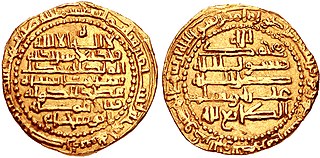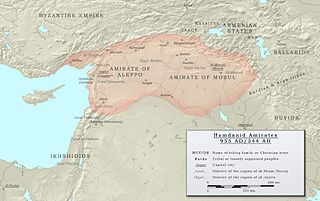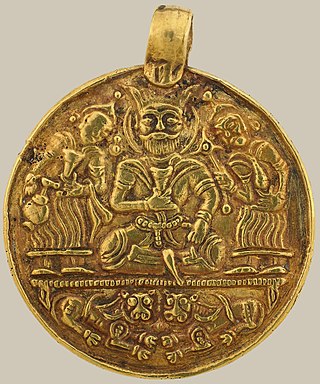Related Research Articles

The Buyid dynasty, also spelled Buwayhid, was a Shia Muslim Iranian dynasty of Daylamite origin, which mainly ruled over Iraq and central and southern Iran from 934 to 1062. Coupled with the rise of other Iranian dynasties in the region, the approximate century of Buyid rule represents the period in Iranian history sometimes called the 'Iranian Intermezzo' since, after the Muslim conquest of Persia, it was an interlude between the rule of the Abbasid Caliphate and the Seljuk Empire.

Abū ʾl-Qāsim al-Faḍl ibn al-Muqtadir, better known by his regnal name of al-Mutīʿ li-ʾllāh, was the Abbasid caliph in Baghdad from 946 to 974, ruling under the tutelage of the Buyid emirs.

Abu Bakr ʿAbd al-Karīm ibn al-Faḍl, better known by his regnal name al-Ṭāʾiʿ liʾllāh/biʾllāh, was the Abbasid caliph of Baghdad from 974 to his deposition in 991. He was in office during the domination of Iraq by the Shi'a Buyid dynasty, and as a result is generally considered a powerless figurehead under the thumb of the Buyid emirs. His tenure was also marked by strife between rival Buyid rulers and the frequent change of hands of Baghdad: al-Ta'i' himself was raised to the throne by a rebel Turkic general, Sabuktakin, who deposed al-Ta'i's father, al-Muti'. During periods of such strife, al-Ta'i' was able to exert some measure of political independence, but under stronger rulers he was sidelined, and was obliged to marry the daughters of the emirs Izz al-Dawla and Adud al-Dawla. Al-Ta'i's status suffered under Adud al-Dawla in particular, who turned to pre-Islamic Persian models for legitimacy, and relegated Iraq to the status of a simple province ruled from Fars. Al-Ta'i' was deposed on 22 November 991 by Baha al-Dawla, and replaced with his cousin, al-Qadir. He spent the rest of his days, until his death in 1003, confined to the caliphal palace.

The Hamdanid dynasty was a Shia Muslim Arab dynasty of Northern Mesopotamia and Syria (890–1004). They descended from the ancient Banu Taghlib tribe of Mesopotamia and Arabia.

Abu Nasr Firuz Kharshadh, better known by his laqab of Baha al-Dawla was the Buyid amir of Iraq (988–1012), along with Fars and Kerman (998–1012). His early reign was dominated by struggles with his rival relatives over control of the western Persian provinces, but by 998 he managed to establish his supremacy over the Buyid confederation. His reign nevertheless saw the increasing encroachment of neighbouring powers on Buyid territory, and marks the beginning of the decline of the Buyids' power. He was the third son of 'Adud al-Dawla.

Abu Kalijar Marzuban, also known as Samsam al-Dawla was the Buyid amir of Iraq (983–987), as well as Fars and Kerman. He was the second son of 'Adud al-Dawla. The Abbasids recognized his succession and conferred upon him the title Samsam al-Dawla. He lacked the qualities of his father 'Adud al-Dawla and failed to have a grip upon his state affairs. His rule was marked by revolts and civil wars.

Bakhtiyar, better known by his laqab of Izz al-Dawla, was the Buyid amir of Iraq (967–978).

Ahmad ibn Buya, after 945 better known by his laqab of Mu'izz al-Dawla, was the first of the Buyid emirs of Iraq, ruling from 945 until his death.

Fannā (Panāh) Khusraw, better known by his laqab of ʿAḍud al-Dawla was an emir of the Buyid dynasty, ruling from 949 to 983, and at his height of power ruling an empire stretching from Makran to Yemen and the shores of the Mediterranean Sea. He is widely regarded as the greatest monarch of the dynasty, and by the end of his reign he was the most powerful ruler in the Middle East.

Abu Muhammad al-Hasan ibn Abu'l-Hayja Abdallah ibn Hamdan al-Taghlibi, more commonly known simply by his honorific of Nasir al-Dawla, was the second Hamdanid ruler of the Emirate of Mosul, encompassing most of the Jazira.
Uddat al-Dawla Abu Taghlib Fadl Allah al-Ghadanfar al-Hamdani, usually known simply by his kunya as Abu Taghlib, was the third Hamdanid ruler of the Emirate of Mosul, encompassing most of the Jazira.
Fuladh ibn Manadhar, was a Justanid prince, who served as a high-ranking military officer of the Buyid dynasty.
Asfar ibn Kurduya, was a Daylamite officer who served the Buyid dynasty.
Abu Ali Hasan ibn Ustadh-Hurmuz, commonly known after his father as Ibn Ustadh-Hurmuz was a Daylamite military officer of the Buyids, and an important figure in the Buyid state during the late 10th century.
Abu Tahir Muhammad ibn Muhammad ibn Baqiyya, also known as Nasir-al-Dawla, Naseh, best known as Ibn Baqiyya, was a statesman of the Buyid dynasty, who served as the vizier of Izz al-Dawla from 973 to 977.
Abu Ishaq Ibrahim, also known by his honorific title of Umdat al-Dawla, was a Buyid prince, who was the youngest son of the Buyid ruler Mu'izz al-Dawla.
Abu Abdallah al-Husayn ibn Nasir al-Dawla was a Hamdanid prince, who along with his brother Ibrahim was the last Hamdanid ruler of Mosul in 989–990. After his defeat at the hand of the Marwanid Kurds and the takeover of Mosul by the Uqaylids, he entered the service of the Fatimid Caliphate.
Abu Tahir Ibrahim ibn Nasir al-Dawla was a Hamdanid prince, who along with his brother al-Husayn was the last Hamdanid ruler of Mosul in 989–990. After his defeat at the hand of the Marwanid Kurds, he was killed by the Uqaylid leader Muhammad ibn al-Musayyab, who usurped rule over Mosul for his family.
Sabuktakin or Sübüktegin was a Turkic commander in the service of the Buyid dynasty. His power was such that he defied the Buyid ruler Bakhtiyar Izz al-Dawla, and even rose in revolt against him in 974, seizing control of Baghdad and threatening to overthrow Buyid rule in Iraq completely. His career was cut short by his own death in late 974. His successor, Alptakin, was defeated by the Buyids and fled to Damascus, where he eventually joined the Fatimids.
References
- 1 2 3 Kraemer 1992, p. 198.
- ↑ Kennedy 2004, p. 230.
- ↑ Turner 2006, p. 16.
- ↑ Kennedy 2004, pp. 272, 230.
- ↑ Donohue 2003, pp. 68–69.
- ↑ Kennedy 2004, p. 272.
- ↑ Kraemer 1992, p. 195.